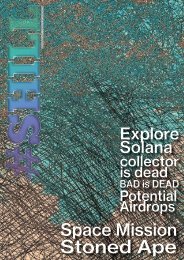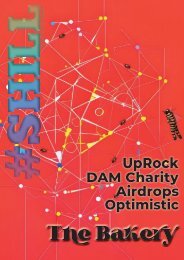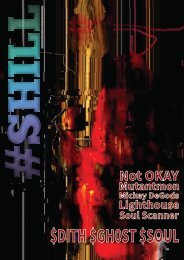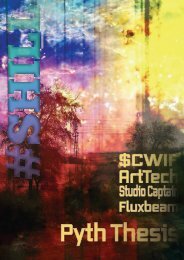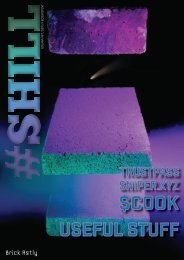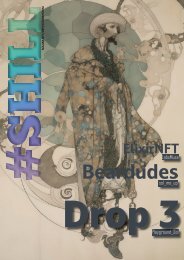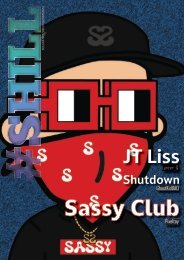SHILL Issue 8
Issue 8- Solana news. In this issue... @sainteclectic @Solanauts @Fractalverse_ @dylanlevi0326 @GLTattooArt @degenpoet @thexastronaut @solananews @AudiusProject
Issue 8- Solana news.
In this issue...
@sainteclectic
@Solanauts
@Fractalverse_
@dylanlevi0326
@GLTattooArt
@degenpoet
@thexastronaut
@solananews
@AudiusProject
- No tags were found...
Create successful ePaper yourself
Turn your PDF publications into a flip-book with our unique Google optimized e-Paper software.
SHILL
SOLANA NFT/DEFI/TWITTER COMMUITY
PAPERHAND NFT’s
The Saint Eclectic is digging deep and
telling you about his strategies as the
NFT market pulls back..
NFT DEGENZ
The Solana community just keeps on
giving. JohnWickedOut puts out a SPotify
feed.
PROJECT SEED
ISSUE #8
0.025 ◎
Project seed is picking up steam as the
team publish a suite of features to look
out for.
In THIS
ISSUE
8
PIXELTOY Magz
2
SHILL Issue #8
4
Opportunity
knocks
The Saint Eclectic takes
a look at the possibiity of
getting in on hard to get NFT.
13 AUDIUS
Have you been sleeping on
Audius? Here is a deep dive
on Audius and where it is
heading.
22
Top HODL Top NFT
Top gainers of the last 7 days
8
9
Solanauts
NFT DEGENZ
JohnWickedOut shares his
new Sporify podcast. Eps2
and 3!
are Go!
First interview for SHILL and
we have a top notch team
answering questions.
24 Holaplex
Brief look at Holaplex for the
week.
SHILL Issue #8 3
Strategies for
NFT's
when
OPPORTUNITY
knocks
The Saint Eclectic is Digging Deep
Today’s flagship NFTs
Cryptopunks BAYC &
Fidenzas cost millions
Even new collections like
@DegenApeAcademy @
SolanaMBS @Thugbirdz can
be cost-prohibitive. How do
you get exposure without
breaking the bank? Enter
Fractionalization: the next
frontier.
To begin, a huge thanks to
@0x1dad for his research & coauthoring
this & @timsamoylov
and @rawrxbt for their insights.
Big things ahead for their @
fraktion_art project which is
building an open protocol to
allow you to mint/buy/sell
fractions of NFTs: https://
fraktion.art
What is Fractionalization?
Fractionalization is the
splitting of one or more
NFT assets into parcels
that are then sold & traded
on a protocol or DEX.
This allows the owner of
the NFT to access some
liquidity while enabling
fraction buyers to gain
exposure to the NFT.
On Ethereum, @fractional_
art fractionalizes
Cryptopunks, BAYCs
amongst other popular
4
SHILL Issue #8
projects. You can see a list of the top fractionalized NFT art
pieces here: https://dappradar.com/nft/fractionalized… Some
VC have even tried this with IRL art.
How does it work?
Firstly, an owner buys a valuable NFT. They then submit it to
a protocol to be fractionalized. In this process they set the
fraction token supply, price and the ‘reserve price’ for the NFT
should someone wish to buyout it out completely.
The NFT is then locked into its own individual ‘vault’ via smart
contract and the owner is issued fractionalized tokens which
they can then distribute to interested buyers via:
- Airdrops
- Direct sales OTC; or
- Decentralized Exchanges
The decentralized exchange distribution option allows
people to buy the fractions permissionlessly. To get it there
SHILL Issue #8 5
the owner will create a liquidity pool on a DEX, pairing the
fractions with popular cryptocurrencies like ETH/SOL/US
stable coins.
While the NFT is stored in the smart contract ‘vault’ it
cannot be accessed, transferred, or traded, guaranteeing an
unbreakable connection between
the NFT and its fractions and
their associated prices.
In the meanwhile, holders of
fractions can realize value by
swapping their fractions for
the other cryptocurrencies in
the DEX liquidity pools. Prices
will move in line with what the
market thinks the underlying NFT
is worth.
The buyout scenario While the
NFT is in the vault it is open for
potential buyers to place a bid
to buy it outright. If they set a
bid above the reserve price, an
auction will be triggered where
others can place competing bids
over a defined time.
Once the sale completes, the
NFT is removed from the vault
and transferred to the new
owner. Fraction holders can
redeem the sale proceeds
proportionally to the tokens
they hold by interacting with the
smart contract protocol.
Nothing is guaranteed, but there
is an important distinction here:
Fractions give you an economic
right to a whole NFT like a piece
of a commodity, like owning
part of a lump of gold. They are
not tokens where holders can
expect returns based on the
management of the NFT owner.
As such, fractionalized tokens
arguably don’t fall afoul of the Howey test. Of course,
nothing is certain, but the best teams will employ a thorough
approach and engage with both regulators and exchanges.
6
SHILL Issue #8
So, where to from here?
Well, with the: - popularity & prices of key collections rising
rapidly; - # of people interested in NFTS increasing every day;
& - dilution of attention with endless new NFTs most of which
fade away. We’re likely to see more demand for affordable
access to key flagship NFTs.
Fractionalization will likely play
a role in facilitating all of this.
Protocols that successfully build
solid smart-contracts to manage
this will likely see an increase
in demand, especially for high
valued NFT projects. Never has
division been so unifying in
crypto.
SHILL Issue #8 7
NFT DEGENZ
AKA
@JohnWickdout
Anything and
everything related to
Solana NFTs. From
minting, to exploring
projects, predicting
markets, to seeing
where this goes big
picture. It’s going to
be an exciting ride
and I’m happy to
take you all along for
the ride!
Episode 2
I go over Coinbase/FTX & their NFT
marketplaces, why it’s significant and
bullish. And then I will touch on Twitters
plans for PFP verification.
Episode 3
In this episode I do a brief overview
of some projects such as Solanauts,
Roguesharks, Shroomz, Skully Boys, RPS,
Bitboat, Galaxy Koalas, and Voxpunks.
LINK TO SPOTIFY
8
SHILL Issue #8
SOLANAUTS
are
GO!
Many projects
that have recently
launched see to
have overpromised
and underdelivered
causing investments
to plummet and
floors to go below
mint price.
Once project that has
bucked the trends is
Solanauts.
I asked the Commish
and the team about
the project and
where they see Zero
G Labs within the
mix.
The first question
that we would like to
explore is who Zero
G Labs actually is/
are?
Mission Control is made up of 3 best friends for over
20+ years. Crypto enthusiasts, entrepreneurs, dreamers,
experimenters, engineers, builders are all words to describe
us. We have each been self-employed at one point and
always wanted to create something our way. We’ve always
had a thirst for more, a bright and vibrant future and creating
an NFT community has become our passion.
SHILL Issue #8 9
You have your team, Zero G Labs, and then you come up with
a concept. Was Solanauts your first concept and how did it
develop?
We actually came up with the Solanauts first. We were hyper
focused on building a unique NFT collection that wasn’t like
all the other 10,000 NFT collections at the time. As we were
building, more light bulbs went off and realized that we could
be bigger and better than just a 500 NFT community. Once we
realized how big the opportunity ahead of us was, we landed
on Zero Gravity Labs as our parent company to represent the
endless possibilities in our universe. Zero gravity reflects a
frictionless environment and if our minds can operate in a
frictionless capacity, our imaginations can take humanity to
new heights.
Why the Solana chain?
Solana offered a once in a lifetime
opportunity to create from scratch
under a new set of rules. We view
Solana as a metaphorical nation
state. It has its own currency, its
own ‘dialect’, its own businesses that
create a flourishing economy and
it has unlimited opportunity to add
more. Having the chance to create a
community under this color palette, this
type of communal energy, these TPS
capacities, was an opportunity we never
wanted to pass up.
As Solanauts was launching many
other projects were having trouble with
failed or glitched launches that resulted
in angry community members. How
did Zero G Labs manage to avoid this
10
SHILL Issue #8
scenario?
We pride ourselves in being listeners first and problem solvers
second. When we arrived, we observed the challenges both
from the creator side as well as from the consumer side (we
buy NFTs too!). Having both of these hats allowed us to slow
down, listen to creators feedback and community sentiment
to actually build something we can be proud of. We never
rushed anything and believed in our vision. We have been so
fortunate to attract the type of community we have today. A
truly humbling experience.
Solanauts launched and sold out. The floor has maintained a
healthy price never dipping below mint price. What do you put
this down to?
It’s hard to say because the community determines the value.
We keep our heads up high, network and make friends, build
and imagine, collaborate and challenge.
At the end of the day, each individual is
responsible for determining the perceived
value and it all boils down to game theory
behaviors.
Recently, the team launched the Zero G
Launch Pass. What is the role of the pass
within the project?
The role is simple. Help grow our
community larger than our Genesis 500
NFT collection. We wanted to provide
an opportunity for those who missed
getting a Solanaut or wanted something
else from us to be able to feel rewarded
for sticking around while we built. The
Launch Pass was the first of kind
tokenized whitelist on Solana. A way for
holders to be eligible for airdrops, obtain
pre-sale access and have discounted mint
SHILL Issue #8 11
prices on our future
collections. We gave
half away for free and
the other half for near
free.
The Solanaut project
has managed to
collaborate with some
high-profile artists
over the course of
its existence. Can
you highlight some
of these and what
it meant for your
community?
This is one of our favorite parts of running a collection, being
able to partner with so many talented artists. We were so
inspired by 20+ artists on Ethereum that we wanted to help
build the next wave of elite artists on Solana. Artists like
Peanug, Pink, Joseph Taylor, Fede, 0x Drip and more… what a
treat to be able to give their artwork to our community!
Where to next? What does the team have planned for
Solanauts as an NFT collection moving forward?
Being brand builders, it is our mission to build something for
everyone. We want the community to grow and understand
our thesis of building a truly best-in-class community.
Whether it’s recognizing effort, giving back, donating to
charities and more, we want to be known for our mission
statement first. The way we do that is by introducing new
personalities into the fold. So we are excited to launch our
Solana Anonymous collection, a very unique approach to
building a collection that can tell a story.
Nothing else like it.
Hope you enjoy it!
12
SHILL Issue #8
AUDIUS
Music Sharing Platform of the Future?
Author: Phemex Contributing Writer Date: September 27, 2021
Taking on behemoths like Spotify and Amazon Music
services would require balls of steel. Or maybe,
just maybe you have a market play that these other
services are still toying with? In this game being one
step ahead can make all the difference,
Today’s music industry often finds itself favoring corporations
over the creators. Many times, artists have lost out to production
companies when it comes to financial rewards, getting stuck
in restrictive contracts or only receiving a tiny percentage of
the money their music makes. Moreover, with online streaming
platforms such as Spotify and YouTube music, it has become
even harder for musicians to earn a decent wage for their work.
Audius’ whitepaper reminds us that:
“In 2017, the music industry generated $43 billion in revenue
but only 12% of that made its way to artists. As points of
comparison, NFL players capture at least 47% of the revenue
generated by the entire NFL, and NBA players capture between
49 and 51%.”
It’s clear that musicians are exploited more than their sports
counterparts, and thus Audius was created to address these
issues.
What Is Audius?
Audius was started in 2018 as a decentralized, communityowned
music sharing protocol that offers music streaming
services. The idea was to create a censorship-resistant music
platform where artists can cut out the middleman to take
home a much higher proportion of profits. Additionally, it is a
transparent platform where they can have more control over
their music.
The idea had already begun taking form as far back as 2014,
SHILL Issue #8 13
when Warner Music Group (WMG) signed a licensing deal with
Soundcloud, the most popular (and free) music streaming
service at the time. The deal resulted in the use of overly
restrictive copyright infringement rules to remove many artists
from the platform, meaning further barriers for independent
artists. This meant many artists lost revenue and exposure,
while their fans lost a way to listen to them. Although Audius’
concept took shape here, the lack of available technology
hindered it from being built.
The Ethereum
blockchain’s
development of
smart contracts to
independently link
musicians and fans,
alongside new online
storage options,
such as IPFS, meant
the opportunity had
finally arrived in 2018.
Following this, Audius
raised $5.5 million
from investment
funds to expand
its operations. By
September 2019 the
project was being
tested on a testnet,
and by October 2020 it was running on its mainnet, and its
AUDIO token was trading on major cryptocurrency exchange
platforms.
How Is Audius Structured?
The Audius protocol consists of three layers:
The app layer: For accessibility, this layer includes the Audius
website, as well as the app for Android and Apple devices.
14
SHILL Issue #8
Using their own non-custodial browser wallet, Hedgehog,
Audius’ founders have been able to create an interface that is
familiar to users and thus accessible and inviting — this is very
much in accordance with the Hedgehog motto: “build dApps
like apps.”
The node layer: Audius’ node layer consists in a layer-2
blockchain that is very similar to Polygon’s. It is built for improved
scalability, while maintaining compatibility with Ethereum.
This is of the utmost importance due to Audius’ reliance on
the Ethereum
blockchain
for its smart
contracts,
blockchain, and
token. Moreover,
as with Polygon,
Audius’ node
layer takes
screenshots of
the information
at any given
time, meaning
that should
Audius go
down, artists
will still be able
to recover their
music. There
are two nodes involved in this storage and retrieval process:
content nodes and discovery nodes.
The blockchain layer: To ensure that nodes work in a positive
manner, nodes must stake AUDIO tokens on the Ethereum
blockchain, which forms up Audius’ third and final layer.
However, there is an incredibly high entry point to stake coins
on Ethereum (a minimum of 200,000 AUDIO tokens is needed to
SHILL Issue #8 15
work as a node for Audius and earn the corresponding rewards).
To counter this, Audius’ dashboard works in conjunction with
Metamask to offer users
the chance to delegate
tokens to these nodes.
This allows for a lower
point of entry and thus
higher decentralization,
since these nodes will
have a say in governance.
Audius’ Content Lifecycle.
(Source: Audius Oct 2020
whitepaper)
Who Is Behind Audius?
Audius’ co-founders are
Roneil Rumburg and Forrest
Browning, both of whom
are programmers with
an Ivy league education.
Forrest Browning is in
fact a Forbes 30 Under 30
recipient.
Rumburg and Browning got into crypto at the very beginning,
having mined Bitcoin (BTC) as early as 2011, and having
sold their coins at the peak of the bull run in 2013. Both are
crypto veterans, having gone on to found their own companies
centered around cryptocurrency and blockchain technology
before coming together to create Audius.
However, there is controversy around Audius’ co-founders, as
even though Rumburg and Browning are listed as co-founders,
another individual is also credited in many online interviews
and articles. Ranidu Lankage is a Sri Lankan pop singer and
DJ who, if he is to be believed, was a co-founder of Audius who
was then erased from all its archives. This seems far-fetched,
but it does have some plausibility. A crypto Youtuber with
16
SHILL Issue #8
over 1.35 million subscribers known as Guy from Coinbureau,
points out in his video that there are major gaps in Audius’
timeline which could, he argues,
be the result of a falling out.
These gaps can be seen by long
time lapses between posts on
the Audius blog during 2018 and
2019. Since the project did not
go live on the mainnet until late
2020, it could be that they were
simply focusing on other things.
NFT Music: Audius and Solana
Audius is currently switching to
using Solana as a layer-2 solution.
This has been done in order to
ensure scalability, since Audius’
userbase is reportedly growing
at an exponential rate — 500,000
to 5 million monthly users in less
than a year — and Ethereum is
infamously slow. Alongside this,
however, has come the bonus of using Solana’s non-fungible
tokens (NFTs) on the Audius platform. Up until now, Audius
could only use NFTs minted on Ethereum, but this partnership
with Solana opens a much wider range. Those with Audius’
silver-tier profiles — accounts that hold up to 100 AUDIO tokens
— can now display both Ethereum and Solana NFTs. Musicians
on Audius can use NFTs for their album covers, listeners can
use them as their profile pictures, or collections of NFTs can
simply be displayed on the Audius platform.
This partnership creates more lines running between different
platforms and arguably helps in bringing crypto users closer,
slowly stitching the whole metaverse together. With crypto
moving in this kind of direction across the industry, we should
be seeing more protocols working together as opposed
SHILL Issue #8 17
to competing,
thereby creating
more growth in the
sector.
A u d i u s
Controversy
Other than the
mysterious case
of Ranidu Lankage
and the missing
blog posts,
Audius has a few
more questions
that remain
unanswered.
Audius’ dashboard
states that it has
a unique monthly
user base of over 6 Audius’ total plays and total unique users in one month (Aug-S
million people, but
its number of total plays and unique users, which are published
just below, state that these are closer to the 200,000 point.
Moreover, its twitter account has only 82.8 thousand followers,
and its Instagram only has 30.9 thousand. This seems strange
for a platform that is bound to have quite a young userbase
— listeners who are not only looking for music but that also
understand the technology enough to find it.
Finally, there is a whitepaper from September 2018, that was
published on the Audius site but has since been replaced.
This whitepaper showed a completely different strategy to the
current Oct 2020 whitepaper, and crucially, different authors.
This could lend credence to the idea of a change of team
(Ranidu Lankage for example); however, it is understandable
that the project will have evolved as it went through the testing
18
SHILL Issue #8
phases.
Audius Tokens and
Tokenomics
Audius currently
has its own ERC-20
utility token, AUDIO.
It is used for staking,
governance, and to
unlock rewards on the
Audius platform. It has
an initial supply of 1
billion tokens, with only
5% of these having
been airdropped to
10,000 of its most
active artists and
listeners. A further 18%
went to the treasury,
ep 2021). (Source: Audius.org)
40% went to the team
and its advisors, and
36% went to Audius’ investors. Its annual inflation rate of 7%
means that tokens will continue to be minted at quite a fast
rate — something that will keep its value down. These newly
minted coins will be distributed to the most active users on
the platform; however, currently these additional coins are
being rewarded to stakers. This inflation rate should help to
balance out Audius’ token ownership, but for the moment it is
quite concerning that the team and investors should hold such
a high percentage. This is not conducive to a decentralized
protocol and leads to questions as to whether Audius’ could
manipulate AUDIO’s value.
By mid-August, AUDIO had begun its bull run with renewed
energy. This was probably propelled by its recent partnership
with the hugely popular social media platform, TikTok, as well
as by its integration with Solana and its subsequent ability to
SHILL Issue #8 19
offer massively trending NFTs. The price soared to around
$3.00 and has stayed between $2.00 and $3.00 since. Despite
the fluctuation, these new partnerships will undoubtedly help
to stabilize it in the short-term, or potentially increase its price
further.
What Is the Future of Audius?
Audius’ TikTok partnership was an incredibly bullish move,
and with its integration of Solana’s NFTs, it has placed itself
in a solid position for growth. This can already be seen by the
amount of celebrity artists that can be seen flocking to invest
in the platform, including Katy Perry, Nas, and Jason Derulo.
This kind of exposure is great marketing for the platform and
could send its value upward in a big way. However, its high
inflation rate will probably keep it from skyrocketing. Audius
has placed itself in a strong position and still has a lot to offer.
It is definitely a platform to watch.
20
SHILL Issue #8
SOLANALYSIS
7D volume
SHILL Issue #8 21
Top GAINERS Top PLATFORMS
The Astronaut @thexastronaut
22
SHILL Issue #8
Top NFT Top DEX
SolanaNews @SolanaNews
SHILL Issue #8 23
Holaplex
DegenPoets
degenpoets.
holaplex.com
GoodLuck
goodluck.holaplex.com
24
SHILL Issue #8
Fractalverse | FLG
Art
fractalverse.holaplex.dev
BiggieDsArt
biggiedsart.holaplex.
com
SHILL Issue #8 25
SHILL magazine
COVER: @APeSY




